Electrical Improvements
NS-1000M crossovers can be improved, to great effect. I’ve developed and tested a series of improvements that I can install for customers with NS-1000s. My focus here is everything in the signal path, so a good starting point is the series capacitor feeding the tweeter. A modern polypropylene capacitor dramatically improves things, and that’s just the start.
I replace the capacitor array feeding the mids. In their place, I’ve used precision Russian military paper-in-oil capacitors as you see below. Alternatively, I use quality polypropylene capacitors. This yields a significant improvement in performance, most notably in clarity and harmonic richness.
Finally, I replace the large bipolar electrolytic capacitors in the network feeding the bass driver. Here, I’ve used with gorgeous ERO vintage parts. Now I use massive polypropylene capacitors matched to very tight tolerances.
Here you see the large red Russian paper-in-oil (PIO) capacitors that I used in the midrange filter. The larger one is in series, feeding the midrange dome, replacing the array of silver Nichicon metallised film caps at the bottom. Paralleled with this is the green MKP cap you see out to the left, yielding the required 21uF. The smaller PIO cap feeds the tweeter, paralleled with another ERO MKP film cap. Note I’ve bypassed each array with a mil-spec Siemens 0.1uF film cap.I graded these Russian PIO capacitors. They are scarily close to their rated values, both 19.7uF, very impressive. I used hot glue to hold things in place.
Distortion
Yamaha designed and manufactured all three NS-1000M drivers. They didn’t rely on third-party parts or designs and were able to customise these drivers to perfectly suit the NS-1000M. This rarely happens now, drivers are almost exclusively supplied by Scanspeak, SEAS, Morel, Vifa, Peerless etc.
All three drivers in the NS-1000M have large magnet assemblies, especially the midrange driver. The large magnets provide a very high magnetic flux density. This, in turn, means the drivers are quite sensitive, which means the speakers don’t need a lot of power to play loud. They do however need a fair bit of power to control them properly.
The high sensitivity and good power handling, aid the speaker’s fine detail retrieval and help reduce system distortion. The combined effect of the highly linear motors and lightweight driven elements mean that these speakers exhibit extremely low distortion across the spectrum. In fact, in a famous test conducted by HiFi News back in the day, of all the loudspeakers tested, the Yamaha NS-1000M exhibited the lowest overall measured distortion.
Особенности
Подавляющее большинство технических решений, которые использовались в этой АС, были рассчитаны на получение максимальной верности воспроизведения. В качестве акустического оформления, жертвуя некоторой частью громкости, но снижая вероятность паразитных резонансов, был выбран закрытый ящик.
Корпус устройства изготавливался из толстой (3 см) фанеры (различных сортов древесины в зависимости от модификации), при этом, несмотря на относительно большой объем (50 л), обладал небольшой массой (от 38 до 31 кг для каждой из модификаций). Применение толстых стенок, внушительного слоя войлочного демпфера и плотное нашпиговывание корпуса минеральной ватой позволили свести к минимуму вероятные паразитные резонансы. В зависимости от версии корпус покрыт уретановой краской или толстым лаком, что вызывает ассоциации с роялями компании YAMAHA.
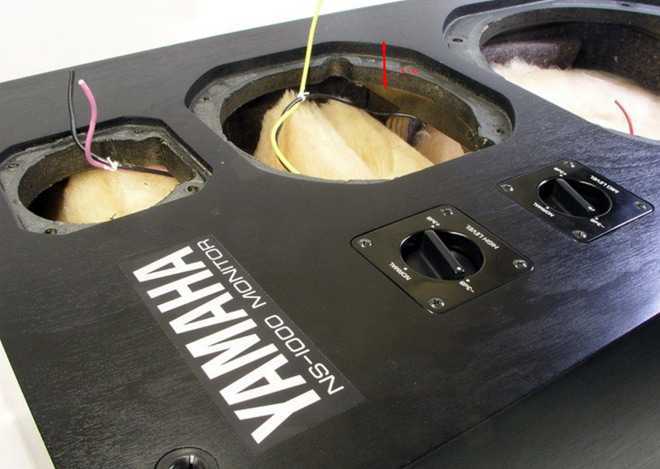
Одновременно с основной моделью появляется студийно-профессиональная версия NS-1000M (monitor). Модификация отличается ещё более ровной АЧХ за счет использования другого НЧ-динамика. В NS-1000 применялся JA-3058 с более “окрашенным”, “насыщенным” (читаем между строк: с более горбатой АЧХ), для мониторной версии 1000M применили “холодный” и “бесстрастный” JA-3058A с совсем нейтральными амплитудно-частотными показателями.
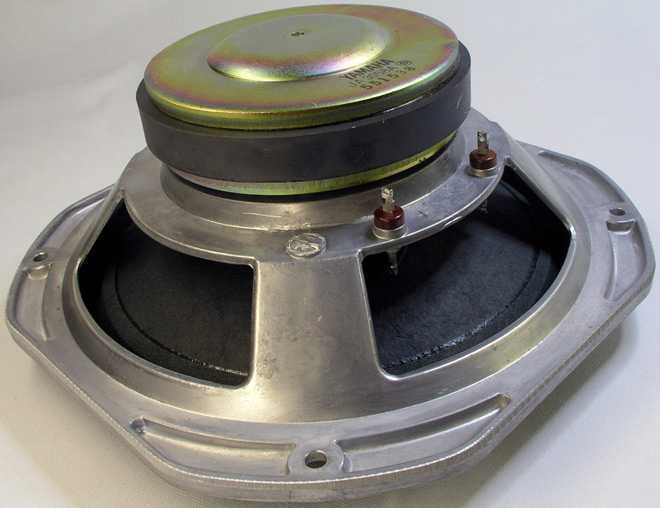
Также для мониторной версии были внесены некоторые изменения в фильтр (кроссовер), в частности использована другая катушка. Задачей этих изменений стало получение ещё более высокой верности воспроизведения.
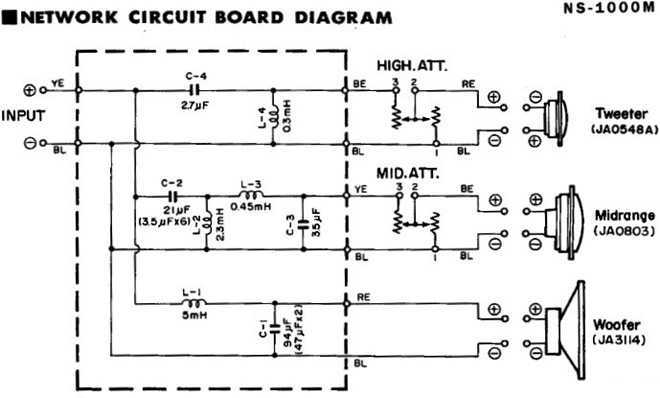

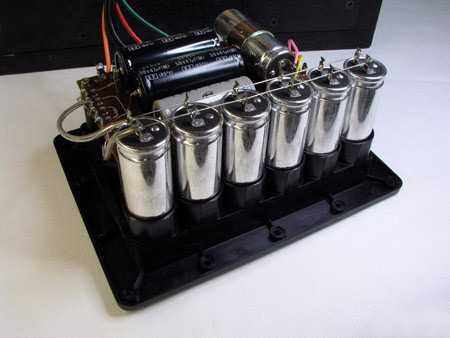
Но наиболее существенным отличием мониторной версии от домашней стало лакокрасочное покрытие. Оно не несло существенной акустической нагрузки, но эстетически домашний вариант был более роскошным, а кроме того, значительно более устойчивым износу. Роскошь и долговечность уретановой краски обошлась пользователям более чем в лишних 8 килограммов веса и почти треть стоимости.
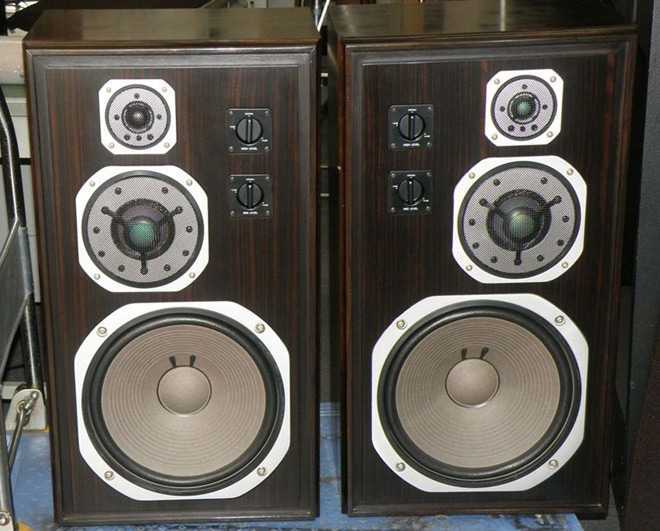
«Богатый декор» NS-1000 за 290 000 иен
Технические и прочие характеристики устройства, были сравнимы с существующими в то время аналогами и порой превосходили флагманы основных конкурентов:
- Частотная характеристика: 40Hz — 20.000Hz
- Частоты кроссовера: 500Hz, 6kHz
- Нижняя резонансная частота: 40Hz
- Чувствительность: 90 Дб
- Мощность номинал: 50 Вт
- RMS: 100 Вт
- Импеданс: 8 ом
- Размеры: 375 x 675 x 326 мм
- Вес: 31 кг (NS-1000)/39 кг(NS-1000M)
Борьба частотных акцентов
В 60-е завершился период экспериментов и каждый крупный производитель АС создавал новые продукты с характерными концептуальными отличиями. Для новых флагманских колонок одним из таких отличий были характерные особенности звучания, которые позже превратились в канонический стандарт.
В противовес не слишком достоверному, но впечатляющему углублению НЧ-спекта в Technics и выпячиваю вокальной середины у SONY, специалисты YAMAHA решили сделать максимально ровную, т.н. мониторную АЧХ, а также основательно поработали с улучшением качества верхов и средних.
Для снижения искажений на СЧ и ВЧ компанией были впервые использованы металлические бериллиевые драйверы. Именно технологи YAMAHA первыми поняли, как обрабатывать этот капризный металл и применили его при создании полевых транзисторов и динамических громкоговорителей. Для этого использовалась разработанная инженерами компании технология вакуумного осаждения, распыленного бериллия.

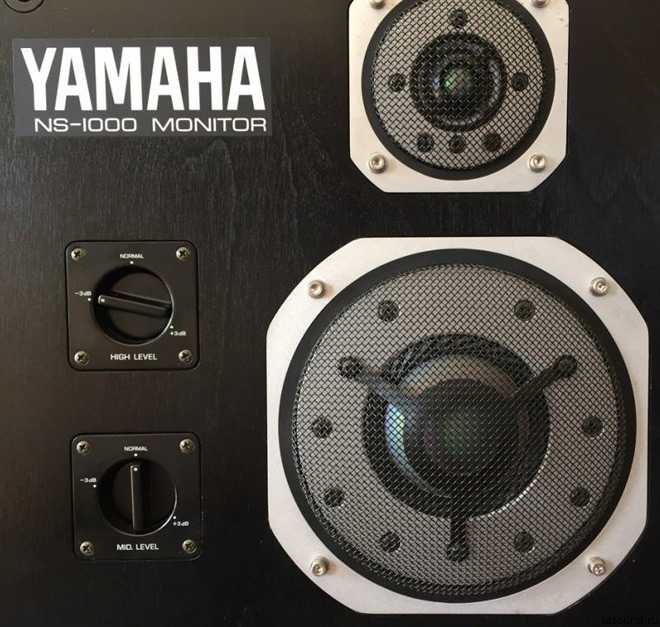
Бериллиевые ВЧ и СЧ драйверы NS-1000
Свойства бериллия, которые побудили применять его для создания динамиков — это сочетание жесткости с низкой массой, также непревзойденная излучающая способность.

Introduction
All products are a set of compromises. Audio equipment is no different, some of it being more heavily compromised than others. That being said, the Yamaha NS-1000M contains fewer compromises than most loudspeakers. Indeed, the NS-1000M is one of the least compromised designs ever produced for the mass market.
My NS-1000s on stands of my own design.
So, what are the compromises in the NS-1000M? Well, their size limits the bass extension possible. Yamaha chose a sealed box design for phase accurate bass, that gradually rolls off, but there isn’t much available sub 40Hz.
Sound pressure levels are limited by sensitivity and power handling, due to voice coil design. the play loud, trust me on that. The 50 Watt limit is conservative. I run mine off a 500 Watt per channel Perreaux 5150B and they sound sublime and go very loud! There are no other compromises in terms of sound quality.
Versions
This classic stand-mounted monitor came in two versions. The NS-1000M features a black ash veneer and weighs 31kg. A more up-market version called the NS-1000 comes in a rosewood veneer and features an even heavier 37kg per box.
The Yamaha NS-1000M sprang from Yamaha’s wish to create a premium monitor-style loudspeaker for home and studio use. The goal was a design that raised the bar in terms of neutrality and resolution.
By definition, monitors are references, used when mastering and monitoring the mix in recording studios. The goal is to make sure the mix is right and that it will sound right on really good equipment. To achieve this, the NS-1000M features several design considerations that make them extremely desirable for use in a home hi-fi system.
Bob Clearmountain’s Tissue
Bob Clearmountain’s other significant claim to fame is probably that he was the first to use tissue paper over NS10 tweeters in an attempt to dull their over-bright balance. He resorted to tissue paper after the maintenance staff at The Power Station had refused to modify the speakers by wiring resistors in series with the tweeters (why he didn’t simply put an HF shelf EQ in the monitor chain is a question for which I don’t have an answer). Yamaha’s second-generation NS10, the NS10M Studio, had a less bright balance, so removing the need for tissue paper. There’s a technical analysis by Bob Hodas examining the effect of covering the NS10 tweeter with various types of tissue paper here: www.bobhodas.com/tissue.html
Новый сабвуфер Yamaha NS-SW1000 — впечатляющая мощь
Компания Yamaha, проявляющая в последнее время повышенную активность на рынке потребительской электроники, представляет новый сабвуфер, который без сомнения порадует любителей острых ощущений. В самом деле, NS-SW1000 демонстрирует впечатляющую мощь с усилителем на 1000 Вт.
Yamaha NS-SW1000 выделяется очень привлекательным дизайном и выпускается с тремя вариантами лаковой отделки корпуса (черный, серый и белый цвет). Органы управления на передней панели из текстурированного алюминия и высокие ножки – на всем отпечаток высокого качества, надежности и долговечности.

Новинка в сочетании с цифровым усилителем мощностью 1000 Вт использует НЧ динамик с диаметром диффузора 30 см. Как обычно, мощность без системы управления мало что значит. Yamaha применяет в этой конструкции самые совершенные технологии обработки аудио сигналов. Таким образом, мы находим известную технологию Advanced YST (Advanced Yamaha Active Servo Technology), которая балансирует импеданс динамика, чтобы добиться идеальной линейной характеристики. Для этого необходимо взаимно корректировать работу динамика и усилителя при воспроизведении звука.
Для устранения интерференции акустических потоков отверстие фазоинвертора выполнено по технологии Twisted Flare Port, что гарантирует постоянный поток воздуха. Соединения деталей корпуса выполнены с использованием фирменных решений Yamaha. Благодаря инновационной обработке аудиосигнала и совершенной конструкции корпуса обеспечивается частотная характеристика от 18 до 160 Гц.
Основные характеристики Yamaha NS-SW1000:
- Активный сабвуфер
- Мощность: 1000 Вт
- Фирменная конструкция корпуса
- Оптимальное управление резонансами
- Twisted Flare Port
- Advanced YST
- Мощный трансформатор
- Цифровой усилитель Yamaha
- Низкий импеданс всей конструкции
- Устойчивые высокие металлические ножки
- НЧ динамик, 30 см
- Частотный диапазон: 18-160 Гц
- Автовыключение
- Размеры: 440 х 459 х 522 мм
- Вес: 41 кг.
Yamaha NS-SW1000 появится в продаже с января 2015 года, стоимость пока неизвестна.
Подробнее о бренде Yamaha
СЛЕДУЮЩАЯ НОВОСТЬ
Караоке AST-50 — специально для домашнего кинотеатра
ПРЕДЫДУЩАЯ НОВОСТЬ
Christie представляет модульные LED дисплеи Velvet высокого разрешения
|
Главная страница > Новости > Новинки > Новый сабвуфер Yamaha NS-SW1000 — впечатляющая мощь
Достижения
Можно смело говорить, что конкурентами этой модели по популярности могут выступать только бюджетные образцы, в своем ценовом сегменте она была наиболее востребованной на протяжении последних 30 лет прошлого столетия. Даже учитывая баснословную стоимость — 216 000 (для NS-1000M — $2,993), мониторная версия колонок YAMAHA в 1976-м году обошла по объему продаж мониторы от Matsushita, SONY в Японии и Tandberg, Celestion, Bang & Olufsen и Bowers & Wilkins в Европе.
Этому во многом поспособствовал заказ на 1000 экземпляров от шведской государственной телерадиовещательной корпорации, где модель стала официальным монитором компании. Ещё через 2 года примеру соседей последовала финская национальная телекомпания и заказала 200 единиц NS-1000M.
Интересно, что консервативный Европейский аудиорынок очень тепло встретил японскую новинку и чопорная западноевропейская пресса, как бы не замечавшая японских производителей до середины 80-х, сделала исключение для этих мониторов YAMAHA.
Модель NS-1000M перенесла несколько переизданий, в 1992-м с обновленным дизайном она была выпущена крупной серией под названием NS-2000, через 4 года интерес к ней снова возник и её еще раз запустили в серию в модернизированном варианте под названием NS-1000X. Выпуск АС, которые можно считать наследниками концепции NS-1000, продолжается и по сей день — это NS-5000, которые, по мнению специалистов YAMAHA, будут не менее популярны, чем их легендарные предшественники.
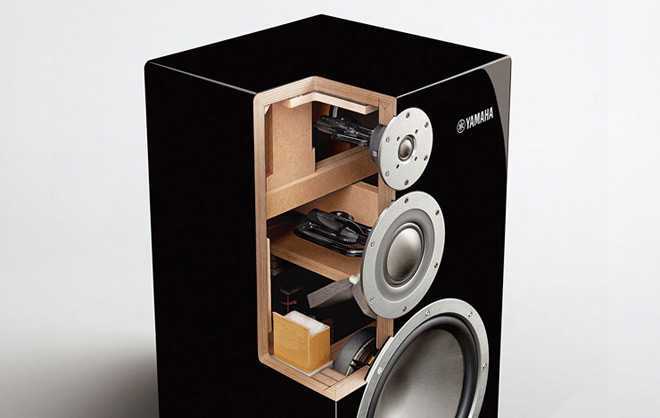
NS-5000
Журнал “Stereophile” включил NS-1000M в свой почетный ТОП-100 лучших акустических систем.
Protection
One thing that might not look particularly aesthetically pleasing, but which usually preserves the condition of those amazing drivers in the NS-1000Ms are the driver guards protecting each driver. The delicate beryllium domes of the midrange and tweeter are rarely damaged because of this excellent driver protection.
One of the best things about these speakers is ironically the somewhat ugly grilles – they protect the delicate drivers from prying fingers…These gorgeous beryllium tweeters don’t produce much sound above 20kHz, but what’s there is clean, crystalline treble with very low distortion.
Contrast this with the NS-1200 for example, featuring very similar, but unprotected drivers, almost always horribly dented and damaged.
Full Mundorf
Yes, I’ve gone full Mundorf! I’ve recently trialled and tested (2021) a serious full Mundorf / Panasonic polypropylene capacitor crossover upgrade in my own NS-1000s and it’s fantastic. I’ve just finished this upgrade for a set of customer NS-1000 crossovers. You can read his comments further along in this article, but let’s just say that everyone who’s heard this has stated that it’s is a heavyweight improvement.
Beautiful sounding and very expensive all polypropylene crossover upgrade I’ve developed. Developed? Yes, developed. I had to mock everything up, measure, test-fit, work out what should go where, trial the capacitor removal you see here, purchase a lot of very expensive capacitors and on it goes. These sorts of things take time, effort and money. I’ve done two sets of speakers with this latest iteration and it’s very, very good. Note that I’ve removed all the old Nichicon metalised film caps in my pair of crossovers here, a painful process but one that yields more room.
Beryllium
Yamaha had all the R&D and resources necessary to create the world’s first beryllium dome drivers, for use in the midrange and treble drivers of the NS-1000M. Why beryllium? Because it is the stiffest and lightest material available for loudspeaker dome design. Stiffness and lightness translate into higher sensitivity, faster transient response and better retrieval of fine detail.
These great dynamic attributes help create the incredible air and detail these speakers are known to produce. It is incredibly hard to manufacture and work with beryllium, but its unique properties imbue the NS-1000M with a unique sound.
The greenish beryllium domes are oh so pretty, and dangerous to make…
The Bottom Line
Yamaha decided to resurrect the venerable NS-1000M in the form of the stunning new NS-5000. You can read a great review here @ HiFi Choice. Loads more details may be found .
In engineering per dollar terms, there’s no way Yamaha could sell the NS-1000 now for less than twenty grand a pair. There’s too much custom engineering, metal, wood, huge magnets and dangerous beryllium. They are worth every bit of that price too. I regularly listen to the latest offerings in that price range and my NS-1000s always give them a real run for their money.
Yamaha has released the NS-5000 in Australia, with a recommended retail price of – wait for it – $ 19,999, so this basically proves my point. The NS-5000 has a nicer finish but in my opinion less advanced/expensive drivers.
Two customers of mine have NS-5000s and they both absolutely love them. One customer drives them with an Accuphase class-A integrated amplifier. He reckons they sound amazing and I’m sure they do!
The other customer recently sent me his NS-1000 crossovers for the full Mundorf upgrade I’m offering these days. He reckons his now upgraded NS-1000s sound better than his new NS-5000s. Interesting no..?!
So, if you find a pair of classic, game-changing Yamaha NS-1000M studio monitors in good condition, with undamaged drivers and matching serial numbers, grab them. Nothing for sensible money comes close. Seriously. Nothing.
Cabinets
Whilst vented boxes are more efficient, a well designed sealed box will have tighter bass and have a gentler 6db per octave roll-off below the resonant frequency of the bass driver and box. With room gain countering this gentle roll-off, the bass response of the NS-1000 can actually be quite impressive.
The typical in-room response is very tight and clean. A sub-woofer can very nicely augment the bottom end of the NS-1000M, with the sealed boxes of the Yammies yielding tight bass down to around 45Hz. These days, I have mine sitting on custom B&W ASW-2500 700 Watt subwoofers. They augment the bass quite nicely…!
As you can see from the photo I took of a very special NS-1000M sliced in half (thanks Pierre @ Revolution TT). The cabinets are incredibly solid, built from a mixture of chipboard and ply. Off-cuts don’t go to waste, used instead as stiffening, inside the box.
Yamaha utilised extensive internal bracing, fillets and cabinet damping materials. They even used the offcuts from cutting out the holes for the woofers to brace the cabinet behind the critically important midrange driver. This approach yields a cabinet of almost ridiculous density. Every time I lift an NS-1000, and it’s irritatingly often, I wince at the sheer mass and density of these black monoliths. Pro-tip: bend at the knees, not the lower back with these babies!
NS10 Variants
During the NS10’s 23-year life Yamaha manufactured a number of different versions (or perhaps just used a number of different logos):
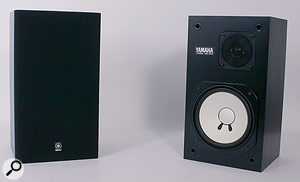 The NS10 started life as a (not very successful) hi-fi speaker: and the original NS10M shipped with cloth grilles, hence the grille-mounting sockets you find in the corners of this model (absent from the NS10M Studio that followed).NS10M: The original domestic hi-fi speaker designed for vertical orientation (its front panel logo reads correctly with the speaker mounted with tweeter above woofer). This is the speaker that was too bright for Bob Clearmountain, leading him to resort to tissue paper over the tweeters — although, of course, it had to be the right kind of tissue paper.
The NS10 started life as a (not very successful) hi-fi speaker: and the original NS10M shipped with cloth grilles, hence the grille-mounting sockets you find in the corners of this model (absent from the NS10M Studio that followed).NS10M: The original domestic hi-fi speaker designed for vertical orientation (its front panel logo reads correctly with the speaker mounted with tweeter above woofer). This is the speaker that was too bright for Bob Clearmountain, leading him to resort to tissue paper over the tweeters — although, of course, it had to be the right kind of tissue paper.
NS10M Studio: Some time after Yamaha got wind of the NS10M’s popularity as a nearfield monitor (and around nine years after the original product launch) a version badged ‘NS10M Studio’ was produced. This version was designed for horizontal orientation (the logo and connection panel text were turned through 90 degrees), incorporated a redesigned tweeter and crossover to address the HF tonal balance issues, featured a more rugged cabinet design without grille-mounting sockets, and had improved connection terminals.
Others: Web searches on NS-10 or NS10 will reveal some variants. There are versions badged NS10M Pro, NS10MX, NS10MC, NS10MT, and a miniature version that was sold in a 5.1 home-theatre package called the NS10MM. I’ve been unable to establish whether the NS10M Pro and NS10MX offer anything different (my guess is that they don’t, but if anybody out there knows anything about them I’d love to hear it), but the NS10MC appears to be an NS10M Studio with a front grille, and the NS10MT appears to be a magnetically shielded and vertically oriented NS10M Studio with symmetrically arranged drivers and, wait for it… a reflex port. Aaaargh!
That Sound
Properly set up and tweaked, the NS-1000s sound amazing. They are airy, clean, smooth, tight, wide open. Really good systems benefit enormously from the insight afforded by a pair of these speakers and, even without modification, these speakers sound remarkable.
The NS-1000Ms are fast, precise and have amazing off-axis performance. You’ll get a great mid and high-frequency response from all around your listening room and very little beaming. A complaint often levelled at them though is that the NS-1000Ms sound bright.
It’s true that these are brutally revealing speakers. Poor source equipment and material will sound devastatingly bad through a pair of NS-1000s. If you have a harsh sounding CD player or bright amplifier, it will be tough going. Much of my audio setup utilises class-A amplification, FETs and this combination certainly helps to give you a smooth starting point and takes the edge off.
Choose good recordings, played on sweet-sounding gear and these speakers will give you more of the music than you may have ever heard before. The NS-1000M certainly favours tube and MOSFET or VFET amplifiers. Wonderful synergy can be achieved, as Mr Lim of the Affordable Valve Company notes here.
РЕКОМЕНДУЕМОЕ УСИЛЕНИЕ
Во многих обзорах колонок 1000M я встречал фразу о том, что эта модель не требовательна к усилению. Не знаю что тут сказать, но моя пара 500M вообще не звучит с хилыми усилителями. Мои двухблочные усилители и Accuphase и Technics раскачивали эти АС достаточно легко, но при этом я впервые в моем доме выкручивал регулятор громкости до положения 3 часов. Особенно если учесть, что хоть и при меньшем сопротивлении их чувствительность почти на 10 дБ ниже чем у Клипшей (91.5 против 101). Как по мне – это все же тугие колонки и требуют адекватного усиления. Тут невзатяжку покурить не получится…
ЦЕНА И ЦЕННОСТЬ
Многие авторы в своих обзорах зачем-то оперируют ценами в японских йенах на момент выпуска. Это очень важная и хорошо иллюстрирующая покупательскую способность информация, особенно учитывая то, что мы прекрасно осознаем реалии японской жизни и держим в голове помесячный курс мировых валют всей эры золотого века аудио целиком. Я продолжу эту славную традицию и укажу текущую среднюю цену колонок Yamaha NS-500M в Северной Америке – она на сегодня составляет примерно 2270 хорватских кун. Если кому-то лень будет искать курсы валют на 2021 год – маленькая сносочка – это примерно 360 долларов США. На самом деле я посмотрел общедоступную историю продаж – она там колеблется от 300 до 500 долларов в зависимости от состояния. Но 500M – конечно редкость.
Много это или мало? А вот тут как раз и имеет смысл поговорить о ценности. Если такая вещь приобретается для обустройства студии, то есть при помощи этих АС будут зарабатываться деньги – то цена наверно рациональная.
Не берусь судить, рынка профессиональных мониторов я не знаю вообще. Если такие колонки приобретаются для домашнего прослушивания и мы рассматриваем бюджет до 500 долларов – то тут ситуация значительно размывается.
Скажем если бы стоял выбор между 500M и колонками Energy C-7, которые сейчас стоят 450 долларов примерно – тут мой однозначный выбор в пользу Yamaha. У Ямах немного больше объем, более очерченный бас и они не перегружаются так быстро как Energy. Если в качестве конкурента выступает Klipsch KG4 – то тут решение принять совсем не просто. И я пожалуй буду больше полагаться на сравнение их в лоб, для того чтобы явно определить лидера. Собственно, я такое сравнение сделал и даже записал. Ролик чуть ниже на странице, посмотрите, послушайте и решите для себя сами…
ВЫВОДЫ
После всех ушатов упреков, которые я щедро вылил на эти АС может создаться впечатление, что это отвратительное изделие. Совсем нет.
Это прекрасные, незаурядные колонки.
С достоверной, скорее всего, передачей звукового материала. Просто нужно правильно понимать их основное предназначение – это профессиональный инструмент для сведения и контроля записи фонограмм. Эти колонки должны быть особым образом размещены в студии и должны находится достаточно близко к слушателю. Такие условия не всегда возможно соблюсти в обычном жилище, ведь оно, наше жилище – это не специально спроектированная control room. Учитывая все перечисленные особенности я не понимаю, как можно рекомендовать колонки такого типа включая и “легенду” 1000M всем энтузиастам подряд. Это узкоспециальная техника для решения специфических задач, это тоже самое, как рекомендовать любителям винила для домашнего прослушивания диджейские сдвоенные виниловые столы, где в звукоснимателях установлены специальные иглы для скрэтчинга.
Да, возможно, эта серия Yamaha включающая в себя 500M 700M 1000M и так далее – лучшие в мире колонки в своей ценовой категории. Но всегда нужно делать оговорку – ДЛЯ КОГО лучшие и для ЧЕГО? Ответ вы уже знаете – для профессионалов, которые занимаются работой, а не наслаждаются любимой музыкой. Задача таких АС – не сгенерировать эмоцию, а обеспечить точное следование техническим регламентам и стандартам звукозаписывающей индустрии. Поскольку я зарабатываю совсем другими навыками и умениями и при помощи совсем другого оборудования, а от колонок ожидаю эмоцию – эта акустика у меня долго не задержалась.
Mechanical Improvements
The cabinets are incredibly solid but I highly recommend replacing the fasteners that hold the drivers onto the baffle. I use marine-grade stainless steel Allen bolts in place of the Philips-headed screws. Allen bolts allow you to torque the drivers down tightly and offer a definite cosmetic improvement.
The factory speaker terminals are flimsy and only accept small gauge wire. I replace them with gold-plated binding posts. These fit conveniently onto the existing mounting plate and look almost like they came that way from the factory.
Close-up of one of the marine-grade stainless steel Allen bolts I’ve used on my Yamaha NS-1000MsReplacement gold-plated brass speaker terminals.NS-1000 anti-diffraction rings added to my pair. These bring a very worthwhile improvement and are common in more modern designs. They reduce edge diffraction from sharp cabinet edges of boxes like these. What you hear is less edge, more smoothness.
Плод лидерских амбиций
К началу-середине 70-х годов за продукцией японских гигантов YAMAHA, Matsushita Electric и SONY закрепилась репутация мировых лидеров в производстве звуковоспроизводящей аппаратуры. Можно смело утверждать, что до начала 80-х именно эти корпорации делили между собой рынок бытовой и студийной электроники (если, конечно, не брать в расчет микрофоны и наушники, где почти безраздельно царствовал немецкий Sennheiser).
Осознав необходимость в принципиально новом устройстве, японские инженеры начинают неутомимый и неистовый поиск технических решений для новой концепции. Следует отметить, что существовали и объективные причины для создания более совершенных акустических систем. Так к этому времени аналоговые устройства записи и сведения достигли пика своего развития, в дальнейшем их возможности существенно почти не менялись, лишь оптимизировались схемотехническое устройство и конструкция.
Технический уровень записей существенно вырос. В связи с этим возникла необходимость в принципиально новой акустике для студий. Закономерно выросли и требования к верности воспроизведения у меломанов, что породило необходимость в домашнем качественном звуке.
К 1972-му-1973-му — эти процессы привели к тому, что стала очевидна необходимость нового класса АС, которое объединило бы наработки предыдущих поколений и дала бы пользователю вожделенную верность воспроизведения без апелляций и компромиссов. Так на свет появляются ультимативные концепты, претендующие на звание лучшего из шедевров колонкостороения.
В 1973-м в Matsushita завершают разработку и запускают в серию Technics SB-1000.
Не заставляет себя ждать и менее известный сегодня аналог от SONY SS-7200, который также позиционируют как “прорыв” и “новое японское слово” в акустике. YAMAHA напротив, несколько задерживается с разработкой, но в итоге, к 1974-му году выпускает бессмертный бестселлер NS-1000, который почти моментально, без существенных маркетинговых вложений завоевывает аудиторию опытных меломанов и работников звукозаписывающих студий. Старт продаж начинается с 290 000 йен (эквивалентно $4022 сегодня с учетом инфляции).
ПОСОБИЕ ПО ПОКУПКЕ
На основе всех доводов, приведенных выше, для всех кто задумывается о покупке мониторных колонок фирмы Yamaha я предлагаю несколько важных, наблюдений, который для меня кажутся весьма существенными и где-то даже критическими.
Найти 1000M за несколько лет поисков в США и Канаде я так и не смог. Один раз я видел объявление о продаже 1000M на Audiogone. В конце концов я перестал надеяться и стал искать их на японских аукционах. Я пересмотрел там массу предложений и у меня сложилось мнение, что несмотря на спрос на эту акустику и сокращающееся предложение – там все еще можно купить приличные экземпляры. Практическая рациональность такой покупки для меня равна нулю, поскольку с учетом расходов на пересылку, таможенные сборы и оплату услуг японскому посреднику стоимость пары АС что 1000M что 500M переваливает разумный рубеж и уходит в другую ценовую категорию.
Crossovers
Yamaha engineers understood the importance of the NS1000M crossover network and they designed it with few compromises. Crossovers sit directly on the rear terminal block. They feature large iron-cored inductors that are unlikely to saturate and non-polar paper-in-oil capacitors feeding the midrange driver.
Slopes are all second-order, which minimises group delay and phase inconsistencies. The midrange and tweeter are wired out of phase, relative to one another. This improves the dispersion and reduces cancellation effects near the cross-over point. The series high-pass electrolytic capacitor feeding the tweeter and the large electrolytic capacitors in the bass network are less than ideal. More on these shortly.





























